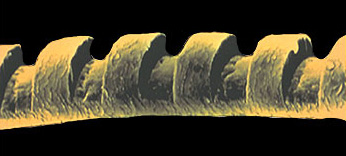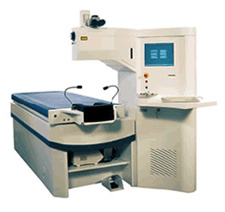 LASER used in Laser Eye Surgery, LASIK, PRK
LASER used in Laser Eye Surgery, LASIK, PRK
The Excimer Laser is the Type of Laser Used in LASIK Laser Eye Surgery

The excimer laser is the most exciting development in eye care since soft contact lenses were developed. It has revolutionized the way the world views eye care correction and has made dreams come true for many individuals with refractive errors (nearsightedness, farsightedness and astigmatism). The word LASER is an acronym for Light Amplification by Stimulated Emission of Radiation. The word excimer is a contraction of the words “excited” and “dimer”. A dimer is a combination of two atoms. In this case the two atoms are fluoride and argon gases. The excimer laser creates a concentrated beam of ultraviolet light that can be precisely focused.
History of the Excimer Laser
The excimer laser was developed at IBM in 1976 and has been used extensively in the creation of computer microchips since its development. Excimer lasers have the ability to produce very precise changes with virtually no effects outside the target zone.
In the early 1980’s a physicist at the IBM Thomas Watson Research Center in New York named Srinivasan and his colleagues proved that ultraviolet radiation from the argon fluoride excimer laser was able to precisely etch organic and synthetic polymers to submicron levels of accuracy. In June 1983, Stephen Trokel teamed up with Srinivasan to show that the cornea of a bovine eye responded to excimer laser radiation while the adjacent tissue suffered no thermal damage. Trokel received a patent in 1983 based on these experiments.
The first normal sighted eye to undergo excimer laser photoablation occurred on January 14, 1987. Since then, millions of eyes worldwide have been treated by the excimer laser via LASIK, PRK, LASEK and epi-LASEK.
How the Excimer Laser Works
The excimer laser generates ultraviolet light of a specific wavelength (193 nanometers) when high-voltage electrical energy is discharged into a cavity filled with the rare gases, argon and fluoride. The argon-fluoride atoms or ions are excited through the application of electrical energy. These energized atoms emit photons (photon is the smallest unit of radiant energy) of light. This beam of light then passes through a series of mirrors and prisms within the laser instrument to enhance the optical qualities of the beam. By controlling the excimer laser pulses with a computer the instrument can create the desired corneal shape.
Biological tissue such as the cornea requires a specific photon energy to break the tissue bonds. When the laser beam touches the cornea, the intermolecular bonds are broken and the molecules are dispersed into the air at a rate of 2,000 meters per second. This leaves a clear, smooth underlying corneal tissue. This process is known as photoablation. The ultraviolet light is absorbed by the molecules of the corneal tissue which breaks the molecular bonds and tissue is virtually vaporized. There is no scarring of the cornea because there is virtually no heat generated in the process.
Pulsed lasers are up to a million times more powerful than a continuous wave laser. This high energy results in the breakage of the cornea molecules’ carbon-to-carbon bonds and the vaporizing of molecules into the air at supersonic speeds!
The energy of the excimer laser is absorbed by tissue containing water such as the cornea. Laser energy itself rapidly diminishes beyond its focal point. Therefore, the ultraviolet laser energy does not penetrate into deeper ocular tissue and therefore does not cause any damage to other ocular tissue.
Corneal Sculpting with Incredible Precision Accuracy
In addition to no scarring, another advantage of using the excimer laser is the incredible accuracy by which the tissue can be removed without any thermal damage to surrounding tissue. Because the high energy of the excimer photon is rapidly diminished as it penetrates tissue, each pulse removes only 0.25 micron of tissue (1/4,000 of a millimeter). About 200 pulses of the excimer would be required to etch through a typical human hair which is about 50 microns in diameter. The following chart and terminology will help you to further appreciate the precision accuracy of the excimer laser.
Basic Terminology
- 1 micron = .001 mm (millimeter)
- 1,000 microns = 1 mm
- Corneal thickness (average) = 530 microns
- 1 corneal epithelial cell = 10 microns
- Depth per laser pulse = 0.25 micron
- Diameter of human hair = 50 microns

Magnified photo of a human hair sculpted by an excimer laser.
Excimer laser used for LASIK and PRK.

